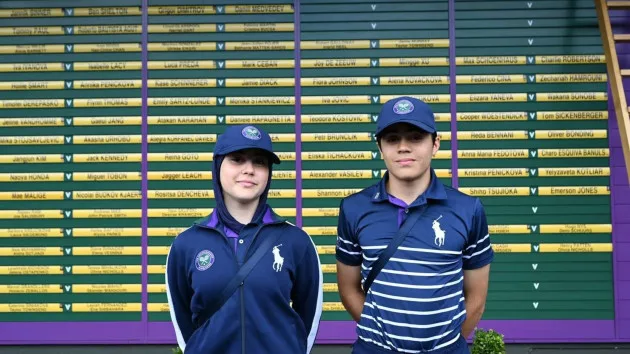(LONDON) — The first thing you should know about becoming a ball boy or ball girl at Wimbledon is that the process is no joke.
In fact, the process is so rigorous and intensive that the acceptance rate of those who get through the training program to work on the hallowed grounds of Wimbledon is on par with being accepted into Oxford or Cambridge University, according to the latest enrolment data from Admission Report.
By the time the tournament comes around in early July, the ball boys and ball girls (BBGs) will have been training for five months, starting in the dead of winter in January or February at the All England Lawn Tennis and Croquet Club facility in Raynes Park, just three miles south of where they hope to end up at The Championships come summer.
Prospective BBGs train once a week with each session lasting approximately two-and-a-half hours. In these sessions, anywhere from 40 to 80 prospective children will train, focusing on general fitness, movement exercises and core skills needed to become a BBG such as rolling, feeding, receiving and game knowledge.
Training is continuous with the only reprieve coming during school holidays, meaning that the candidates have to be fully dedicated to becoming a BBG at a pace that can test both their commitment and endurance.
Alma Hamoud and Rudy Price — both 15-years-old and in their first year working at the tournament as BBGs — are two of the highly skilled ones who made it through the arduous process and took a few minutes in between matches to speak to ABC News on the middle Sunday of the 2024 Championships.
“Staying focused is the hardest thing because you have to watch every ball on every point and react,” Hamoud said. “But I feel really proud to go home and my parents tell me they have seen me on the TV.”
“It is a ton of fun to be a part of such a huge and famous event,” Price echoed. “I feel a lot of pride when I am on the court.”
Both admit, however, that nerves do come into play because they don’t want to make a mistake when TV cameras are everywhere and thousands of people in the crowd can see their every move. It should be noted that they were flawless on the court in the matches watched by ABC News.
The BBGs are essentially trained to be ghosts on the court, part of the pomp and circumstance of Wimbledon but never a feature. Their job is critical — vital — to the flow and pace of any of the more than 700 tennis matches played at Wimbledon as these unsung heroes seamlessly retrieve and deliver balls to the best tennis players in the world, ensuring that they can focus entirely on their game.
“I practiced rolling a lot at home and at sports centers near my house,” Hamoud said as she discussed the training and selection process from the 31 local schools that work with Wimbledon on the BBG program. “Only 10 students make it from each school so it is very competitive.”
The training includes specific routines for scoring — such as knowing which end the balls should be at a given score — and set pieces like marching, the procedures at the start and end of matches, tie breaks, ball changes and even suspended play — every eventuality that they might encounter on the courts.
Throughout the five-month training period, candidates are constantly assessed by the instructor team and are also expected to self-evaluate their performance by identifying key areas for their own improvement.
Sarah Goldson, who oversees the selection process for Wimbledon BBGs and has directed the training since 2012, is the one to make the final selections of approximately 280 BBGs that are chosen from around 1,500 applicants each year, including 170 new recruits and 110 recall applications from those who have served in the previous two Championships.
“I just felt a sense of relief when I found out I got the job,” said Price. “We put in so many hours of training so it all feels worth it now.”
The tradition of BBGs at Wimbledon dates back approximately 100 years to the 1920s and 1930s when ball boys were provided by Shaftesbury Homes, one of the U.K.’s oldest children’s charities and has been active since 1843. But that all changed after World War II starting in 1946 when volunteers from institutions and schools began to take on the role.
The landscape would radically shift again in 1977 when ball girls were introduced to the tournament. From there, it took just three years for mixed teams of ball boys and ball girls to become standard practice in 1980.
It took a further six years for ball girls to make their debut on Centre Court, marking a significant milestone in the tournament’s history just 38 years ago and 109 years after The Championships at Wimbledon began in 1877.
Now, as of 2024, the gender ratio is maintained at approximately 50% for girls and 50% for boys and there are no specific height or weight requirements for the role, though candidates must meet several criteria, including completing the training program, being physically fit and available for training, having thorough knowledge of tennis rules and scoring and prioritizing their commitment to the tournament.
To qualify for the full training program, candidates must score sufficiently across four areas of assessment during the winter trials where the competition is incredibly fierce, the difference between success and failure to becoming a BBG coming down to a mere one or two points in many cases.
Those who get through are then rewarded with even more intense training as the Championships approach and, in May, the BBGs move to training on grass towards the end of the program, including a dedicated grass court week on the Championships courts and during the wildcard playoffs for Wimbledon.
Furthermore, just two years ago in 2022, BBGs participated in the qualifying competition for Wimbledon for the first time, covering 10 to 12 courts over four days, a practice that Wimbledon says is now permanently integrated into the BBG calendar.
This, ultimately, prepares the BBGs for what they have been waiting for — the main event at Wimbledon starting in early July.
“We start at 10 a.m. and we will stay until the last court is closed,” said Hamoud. “It’s a very long day.”
Hamoud isn’t wrong. The BBGs routine involves alternating one-hour periods on and off the court, giving them enough time to take breaks and while ensuring they remain alert and focused throughout the day.
For Hamoud and Price, who both grew up as tennis fans, being on the same courts with giants of the sport is an experience they’ll never forget and even though the demands on their time and energy can be heavy, neither of them would trade the experience for anything.
“I hope I get to see Djokovic,” Hamoud told ABC News. “I really want to see Andy Murray, he is a British legend,” echoed Price.
Both are aware that their experience can open doors to future opportunities within the sport, from playing to coaching to sports management, but whatever comes next and how they’re inspired following the 2024 Championships at Wimbledon is up to them.
After all, Hamoud and Price are getting their start exactly the same way a couple of former ball boys did who you may have heard of — seven-time Grand Slam winner John McEnroe and 20-time Grand Slam winner Roger Federer.
Said Federer in an interview upon his retirement from the game in 2022 as one of the greatest tennis players ever to have played the sport: “At heart, I am always going to be a ball boy.”
Copyright © 2024, ABC Audio. All rights reserved.

